INSTITUT SUPERIEUR D'ANTHROPOLOGIE
INSTITUTE OF ANTHROPOLOGY
ONLINE COURSES / COURS A DISTANCE
WINTER TERM : JANUARY 2016
REGISTER NOW
PEROU – 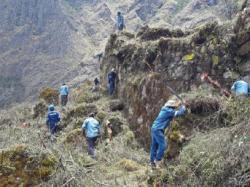 Ollantaytambo - A stone enclosure and a handful of Andean terraces were discovered after a group of staff workers was performing maintenance works in Ollantaytambo, Cusco. The discovery of Andean terraces and a stone enclosure was made in the Ollantaytambo Archaeological Park in Cusco, where the structures had previously been covered by thick vegetation. Cusco’s Decentralized Directorate of Culture announced the work was being conducted to improve maintenance and conservationin the rocky area. Archaeologist and coordinator of the park, Oscar Montufar, said the platforms were built in an area of 5 hectares, according to El Comercio. He informed that they each have different measurements and are accompanied by circular staircases. The discovery so far suggests that the site could have been used to prevent a possible rockslide, to increase agricultural potential or for ritual purposes. Finally, the Directorate informed that part of the enclosure had been damaged due to the construction of the road Cusco-Quillabamba in 1933.
Ollantaytambo - A stone enclosure and a handful of Andean terraces were discovered after a group of staff workers was performing maintenance works in Ollantaytambo, Cusco. The discovery of Andean terraces and a stone enclosure was made in the Ollantaytambo Archaeological Park in Cusco, where the structures had previously been covered by thick vegetation. Cusco’s Decentralized Directorate of Culture announced the work was being conducted to improve maintenance and conservationin the rocky area. Archaeologist and coordinator of the park, Oscar Montufar, said the platforms were built in an area of 5 hectares, according to El Comercio. He informed that they each have different measurements and are accompanied by circular staircases. The discovery so far suggests that the site could have been used to prevent a possible rockslide, to increase agricultural potential or for ritual purposes. Finally, the Directorate informed that part of the enclosure had been damaged due to the construction of the road Cusco-Quillabamba in 1933.
http://www.peruthisweek.com/news-cusco-new-terraces-and-enclosure-discovered-in-ollantaytambo-107938
SYRIE – 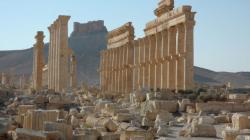 Palmyre - The Islamic State jihadist group executed three people in Syria’s ancient city of Palmyra by binding them to three historic columns and blowing them up, a monitoring group said Monday.
Palmyre - The Islamic State jihadist group executed three people in Syria’s ancient city of Palmyra by binding them to three historic columns and blowing them up, a monitoring group said Monday.
http://www.timesofisrael.com/is-said-to-blow-up-palmyra-columns-to-execute-3/
BULGARIE –  Slatina - “Neolithic settlement in the Slatina residential district [of the capital] Sofia dates back to the 7th millennium BC, which makes it one of the oldest in the Balkans,” said Professor Vasil Nikolov, chairperson of the scientific council of the National Institute of Archaeology with Museum at the Bulgarian Academy of Sciences (BAS), speaking for FOCUS News Agency. “According to latest research, the Neolithic settlement in Slatina dates back to the end of the 7th millennium [BC] and the beginning of the 6th millennium [BC],” Nikolov remarked, adding it was among the biggest settlements in the Central Balkans. “It is not the oldest as there is information about other settlements that are some 100 years older but the difference in time between them is not big,” the scientist noted. In his words, the existence of the settlement in Slatina has been known since the end of the 1920s and excavations there started in 1985. Vasil Nikolov explained a burnt house covering an area of 117 m2 had been discovered then. “In 1985-1997 we established the lay-outs of some 20 houses from the last 2 construction levels of the settlement,” the specialist said. According to him, excavations resumed in 2013 in the western part of the settlement after the municipal authorities came up with the idea and provided financing. “In the first year we found a burnt house from the earliest settlement and, according to radiocarbon dating, it dates back to the 7th millennium BC,” Vasil Nikolov announced. “We found 2 other houses from the earliest settlement in 2015. I hope one of them will be unearthed by the end of excavations in mid-November,” the archaeologist stated. He specified the place where that house was located in the Sofia Valley was a place where peoples from Southwest Asia are believed to have come and a settled civilisation is thought to have appeared. “The Sofia Valley played a highly important function at the time. The settlement in Slatina provides an opportunity to study these connections to the initial centres of the civilisation in Southwest Asia on the one hand and, on the other hand, to study the connections to all other neighbouring regions populated through the Sofia Valley,” Nikolov pointed out.
Slatina - “Neolithic settlement in the Slatina residential district [of the capital] Sofia dates back to the 7th millennium BC, which makes it one of the oldest in the Balkans,” said Professor Vasil Nikolov, chairperson of the scientific council of the National Institute of Archaeology with Museum at the Bulgarian Academy of Sciences (BAS), speaking for FOCUS News Agency. “According to latest research, the Neolithic settlement in Slatina dates back to the end of the 7th millennium [BC] and the beginning of the 6th millennium [BC],” Nikolov remarked, adding it was among the biggest settlements in the Central Balkans. “It is not the oldest as there is information about other settlements that are some 100 years older but the difference in time between them is not big,” the scientist noted. In his words, the existence of the settlement in Slatina has been known since the end of the 1920s and excavations there started in 1985. Vasil Nikolov explained a burnt house covering an area of 117 m2 had been discovered then. “In 1985-1997 we established the lay-outs of some 20 houses from the last 2 construction levels of the settlement,” the specialist said. According to him, excavations resumed in 2013 in the western part of the settlement after the municipal authorities came up with the idea and provided financing. “In the first year we found a burnt house from the earliest settlement and, according to radiocarbon dating, it dates back to the 7th millennium BC,” Vasil Nikolov announced. “We found 2 other houses from the earliest settlement in 2015. I hope one of them will be unearthed by the end of excavations in mid-November,” the archaeologist stated. He specified the place where that house was located in the Sofia Valley was a place where peoples from Southwest Asia are believed to have come and a settled civilisation is thought to have appeared. “The Sofia Valley played a highly important function at the time. The settlement in Slatina provides an opportunity to study these connections to the initial centres of the civilisation in Southwest Asia on the one hand and, on the other hand, to study the connections to all other neighbouring regions populated through the Sofia Valley,” Nikolov pointed out.
http://www.focus-fen.net/news/2015/10/24/387259/neolithic-settlement-in-bulgaria-capitals-slatina-dates-back-to-7th-millennium-bc-expert.html?
ROYAUME UNI – Formby - A fascinating window into the past was opened up by four days of hard graft from volunteers and experts at a recent community archaeological dig at St Luke’s Church, Formby. Volunteers from all over the borough dug a series of trenches that revealed a number of interesting artefacts, including a large piece of carved stone that appeared to date back to the 16th century or earlier. Perhaps it was evidence of the medieval chapel that records show existed on the site before the current imposing church was built – further research will shed more light on this. Carefully digging three trenches in the church grounds quickly revealed deep layers of sand that may date back to the days in the seventeenth century when huge sandstorms on the coast threatened to engulf buildings and communities. But thought-provoking work also showed that the banks around the church may not have been deliberately created as previously thought in the 16th and 17th centuries, but are rather banks of blown sand, pushed to the perimeters of church grounds to form natural boundaries. Further finds included pieces of Tudor beer mugs, and more recent artefacts like an almost pristine Brierley’s Ginger Beer bottle from Southport, which probably dates back to Victorian times.
http://www.southportvisiter.co.uk/news/coast-watch-dig-st-lukes-10310472
ROYAUME UNI – 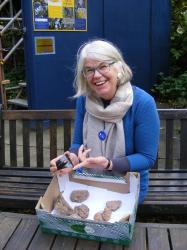 Hereford - Human and animal bones were some of the finds recovered during ongoing restoration work at Hereford Cathedral. Archaeological remains appeared as builders lifted parts of the existing floor of St John's Walk. Under the supervision of the Cathedral archaeologist, Richard Morriss, the area was thoroughly investigated and a number of finds were recovered including human and animal bones, pieces of clay pipe, pottery and oyster shells. Mr Morriss said: "They do reveal some tantalising clues to the past lives of the vicars choral for whom St John’s Walk was originally built."Unfortunately it appears that the finds are mixed up from different periods of history, so dating many of them will be impossible.“Some of the items have already proved fascinating such as the copper stylus for marking parchment, and the fragment of a large tankard, suggestive of ale-drinking, which I am sure the vicars choral who lived in the cloisters would have enjoyed.”
Hereford - Human and animal bones were some of the finds recovered during ongoing restoration work at Hereford Cathedral. Archaeological remains appeared as builders lifted parts of the existing floor of St John's Walk. Under the supervision of the Cathedral archaeologist, Richard Morriss, the area was thoroughly investigated and a number of finds were recovered including human and animal bones, pieces of clay pipe, pottery and oyster shells. Mr Morriss said: "They do reveal some tantalising clues to the past lives of the vicars choral for whom St John’s Walk was originally built."Unfortunately it appears that the finds are mixed up from different periods of history, so dating many of them will be impossible.“Some of the items have already proved fascinating such as the copper stylus for marking parchment, and the fragment of a large tankard, suggestive of ale-drinking, which I am sure the vicars choral who lived in the cloisters would have enjoyed.”
http://www.ledburyreporter.co.uk/news/13897411.Bones_found_during_work_to_St_John_s_Walk_at_Hereford_Cathedral/
FRANCE – 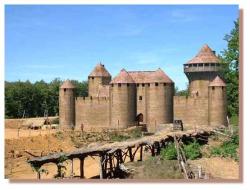 Guédelon - Guédelon est un chantier archéologique unique. Il réunit des archéologues et le savoir-faire de nombreux artisans dans un but original : construire un château avec les techniques du Moyen Âge. L’Inrap (Institut national de recherches archéologiques préventives) nous propose, avec cette vidéo, un voyage en Bourgogne dans les coulisses de ce chantier hors du commun. Débutée en 1997, la construction du château de Guédelon mobilise chaque année plus de 70 professionnels et artisans dans des domaines très variés. Maçons, ferronniers, charpentiers,tailleurs de pierre etc. : tous travaillent à la construction d’un château en n’utilisant que des outils et des matériaux disponibles au XIIIe siècle. Le chantier se situe à une trentaine de kilomètres d’Auxerre, plus précisément à Treigny (Yonne, Bourgogne). À l’abri d’une forêt et d’un étang, dans une ancienne carrière désaffectée. Le site réunit toutes les matières premières indispensables à la construction du château fort.
Guédelon - Guédelon est un chantier archéologique unique. Il réunit des archéologues et le savoir-faire de nombreux artisans dans un but original : construire un château avec les techniques du Moyen Âge. L’Inrap (Institut national de recherches archéologiques préventives) nous propose, avec cette vidéo, un voyage en Bourgogne dans les coulisses de ce chantier hors du commun. Débutée en 1997, la construction du château de Guédelon mobilise chaque année plus de 70 professionnels et artisans dans des domaines très variés. Maçons, ferronniers, charpentiers,tailleurs de pierre etc. : tous travaillent à la construction d’un château en n’utilisant que des outils et des matériaux disponibles au XIIIe siècle. Le chantier se situe à une trentaine de kilomètres d’Auxerre, plus précisément à Treigny (Yonne, Bourgogne). À l’abri d’une forêt et d’un étang, dans une ancienne carrière désaffectée. Le site réunit toutes les matières premières indispensables à la construction du château fort.
VIDEO = http://www.futura-sciences.com/videos/d/chateau-guedelon-laboratoire-archeologique-ciel-ouvert-2985/
TURQUIE - 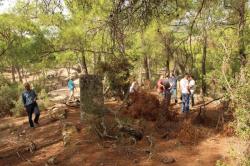 Latmos Mound - A new discovery on Mount Latmus, located near the border connecting Aegean provinces of Aydın and Muğla, has brought the possibility of a second sacred space to the agenda of archaeologists, as the artefact has similar characteristics to the sacred area of Obelisk dedicated to Zeus Agoraios. Latmos Mount was under archaeological works for registration, led by Aydın Culture and Natural Presence Protection Committee and Aydın Archaeology Museum specialists, when the new site was discovered, while the team were exploring the stones used by the ancient site’s residents to establish the boundary lines. The experts also urged there has been various attempts to install mines and mine sites across the historical region, where archaeological sites have been brought to light under ongoing works. “The works for registration and excavation will take dozens of years.
Latmos Mound - A new discovery on Mount Latmus, located near the border connecting Aegean provinces of Aydın and Muğla, has brought the possibility of a second sacred space to the agenda of archaeologists, as the artefact has similar characteristics to the sacred area of Obelisk dedicated to Zeus Agoraios. Latmos Mount was under archaeological works for registration, led by Aydın Culture and Natural Presence Protection Committee and Aydın Archaeology Museum specialists, when the new site was discovered, while the team were exploring the stones used by the ancient site’s residents to establish the boundary lines. The experts also urged there has been various attempts to install mines and mine sites across the historical region, where archaeological sites have been brought to light under ongoing works. “The works for registration and excavation will take dozens of years.
http://www.dha.com.tr/historical-discovery-on-mount-latmus_1057646.html?
GRECE – 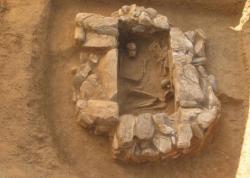 Mytilene - An unlooted stone-built cist grave of the Mycenaean period came to light on Lesvos during improvement works on a rural road. According to the Director of the Ephorate of Antiquities of Lesvos, Pavlos Triantafyllidis, the deceased was placed in a contracted position. Grave goods included a high-footed kylix with a deep hemispherical body, a juglet made of gray clay, a bronze knife and a bronze ring. The valuable burial offerings found date the grave to the Late Helladic III period (1400-1100 BC). The finding is considered very important for the history of Lesvos and particularly for the topography of the Yera area, where at the “Halatses” site an extensive Mycenaean settlement has been revealed.
Mytilene - An unlooted stone-built cist grave of the Mycenaean period came to light on Lesvos during improvement works on a rural road. According to the Director of the Ephorate of Antiquities of Lesvos, Pavlos Triantafyllidis, the deceased was placed in a contracted position. Grave goods included a high-footed kylix with a deep hemispherical body, a juglet made of gray clay, a bronze knife and a bronze ring. The valuable burial offerings found date the grave to the Late Helladic III period (1400-1100 BC). The finding is considered very important for the history of Lesvos and particularly for the topography of the Yera area, where at the “Halatses” site an extensive Mycenaean settlement has been revealed.
http://www.archaeology.wiki/blog/2015/10/26/mytilene-stone-built-cist-grave-revealed/